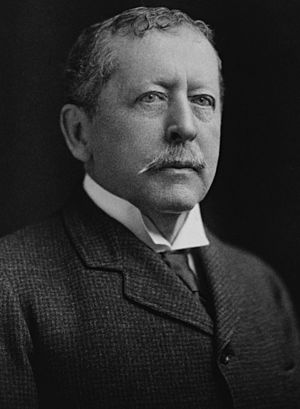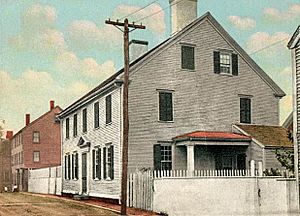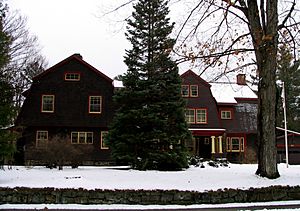Thomas Bailey Aldrich facts for kids
Quick facts for kids
Thomas Bailey Aldrich
|
|
|---|---|
 |
|
| Born | November 11, 1836 Portsmouth, New Hampshire, United States |
| Died | March 19, 1907 (aged 70) Boston, Massachusetts, United States |
| Occupation | Poet, novelist and editor |
| Notable works | The Story of a Bad Boy An Old Town by the Sea |
Thomas Bailey Aldrich (born November 11, 1836 – died March 19, 1907) was an American writer. He is famous for being the editor of The Atlantic magazine for many years, where he helped publish new writers like Charles Chesnutt. He was also a well-known poet.
Contents
Life Story of Thomas Aldrich
Growing Up and School
Thomas Bailey Aldrich was born in Portsmouth, New Hampshire on November 11, 1836. When he was a child, his father moved their family to New Orleans. After about 10 years, Thomas was sent back to Portsmouth. He went there to get ready for college.
He wrote about this time in his life in his book The Story of a Bad Boy (1870). The main character, Tom Bailey, is a lot like young Thomas himself. This book is a semi-autobiographical story, which means it's a fictional story that includes parts of the author's real life.
Starting His Career
Thomas could not go to college after his father died in 1849. When he was 16, in 1852, he started working in his uncle's business office in New York. Soon, he began working for newspapers and magazines.
Aldrich became friends with other young poets and artists in New York in the early 1860s. This group included famous people like Walt Whitman. From 1856 to 1859, Aldrich worked for the Home Journal. During the American Civil War, he was the editor of the New York Illustrated News.
Becoming an Editor
In 1865, Aldrich moved back to New England. He worked in Boston for ten years as an editor for Ticknor and Fields. This company was very respected at the time. He edited their weekly magazine called Every Saturday, which stopped being made in 1875.
From 1881 to 1890, Aldrich was the editor of the very important Atlantic Monthly magazine. As editor, he sometimes disagreed with his publisher, Henry Houghton. For example, Aldrich did not want to publish articles that had been paid for by Houghton's friends, like Woodrow Wilson. When Houghton insisted, Aldrich threatened to quit. He finally left his job in June 1890.
Aldrich's Writings
While working as an editor, Aldrich also continued his own writing. He wrote both prose (like stories and essays) and verse (like poetry). He was very skilled and known for his beautiful poetry.
His many books of poetry include:
- The Ballad of Babie Bell (1856)
- Pampinea, and Other Poems (1861)
- Cloth of Gold (1874)
- Flower and Thorn (1876)
- Friar Jerome's Beautiful Book (1881)
- Mercedes and Later Lyrics (1883)
- Wyndham Towers (1889)
His collected poems were also published in 1865, 1882, 1897, and 1900. Critics often said his poems were similar to those of the poet Robert Herrick.
Aldrich also wrote stories and novels. His collection of stories, Marjorie Daw and Other People (1873), was known for its realistic style and gentle humor. Other books like Prudence Palfrey (1874), The Queen of Sheba (1877), and The Stillwater Tragedy (1880) had more exciting plots.
In An Old Town by the Sea (1893), Aldrich wrote about his hometown of Portsmouth again. His book From Ponkapog to Pesth (1883) was about his travels.

Family Life and Later Years
Thomas Aldrich got married and had two sons. The Aldrich family were good friends with Henry L. Pierce. Pierce was a former mayor of Boston and a very rich chocolate businessman. When Pierce died in 1896, he left his home in Canton, Massachusetts, to the Aldriches.
In 1901, Aldrich's son Charles became sick with a disease called tuberculosis. Thomas Aldrich built two houses in Saranac Lake, New York. One was for his son and the other for himself and his family. Saranac Lake was a leading treatment center for tuberculosis at that time.
Sadly, Charles Aldrich died from tuberculosis on March 6, 1904, when he was 34 years old. After this, the family left Saranac Lake and never returned.
Thomas Bailey Aldrich died in Boston on March 19, 1907. His last words were, "In spite of it all, I am going to sleep; put out the lights." His life story was written by Ferris Greenslet in 1908.
Images for kids
See also
 In Spanish: Thomas Bailey Aldrich para niños
In Spanish: Thomas Bailey Aldrich para niños



